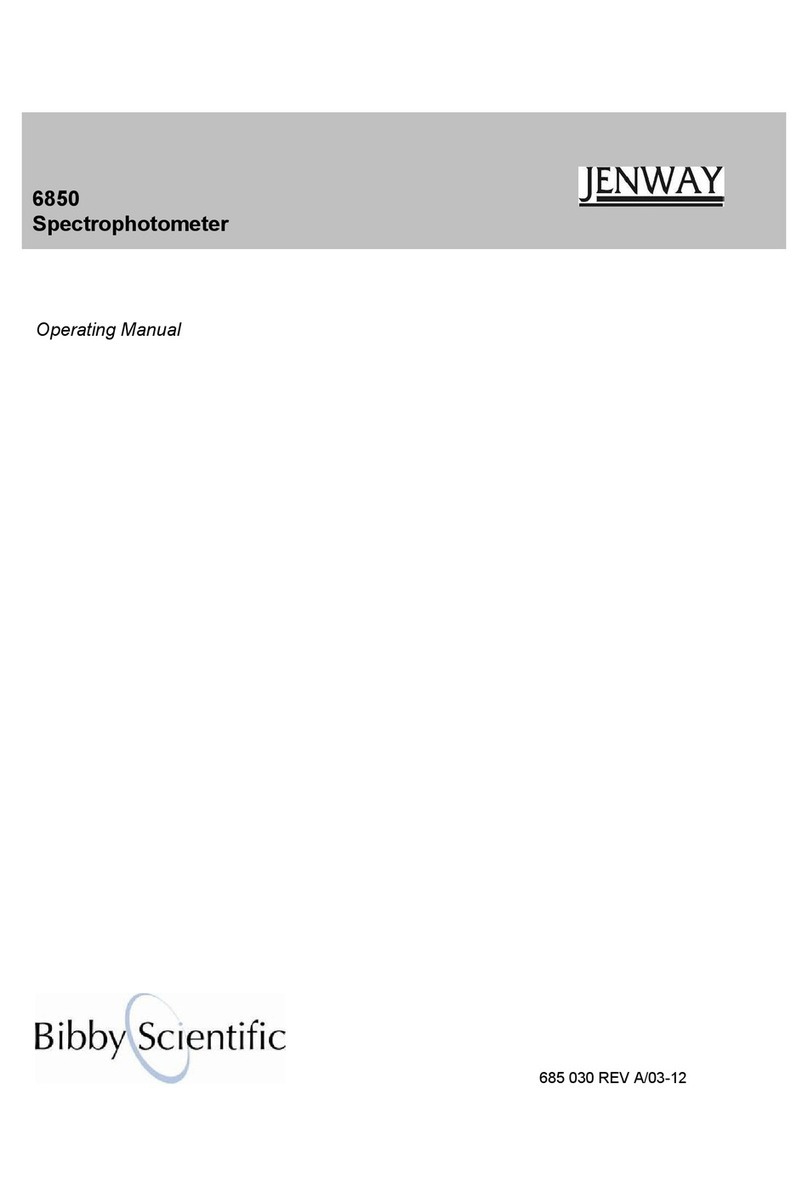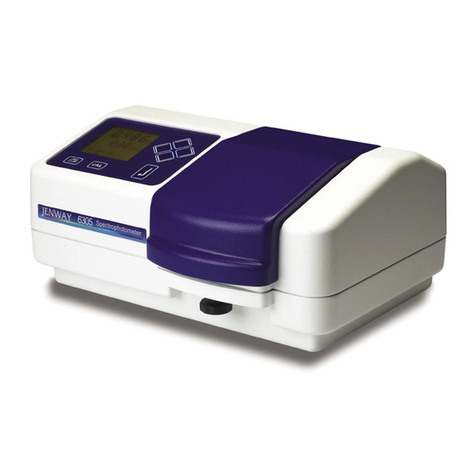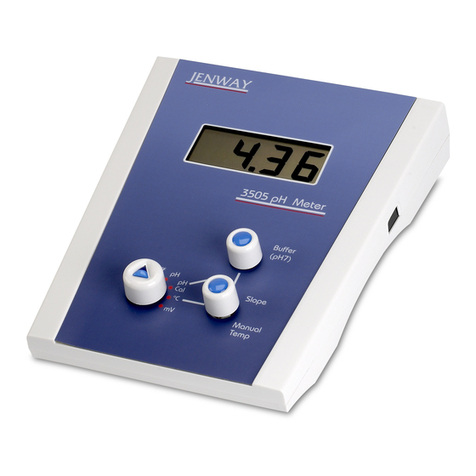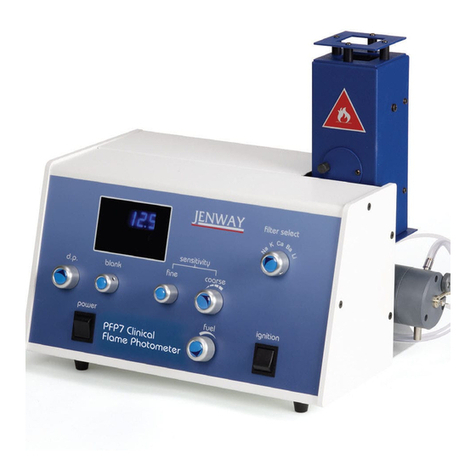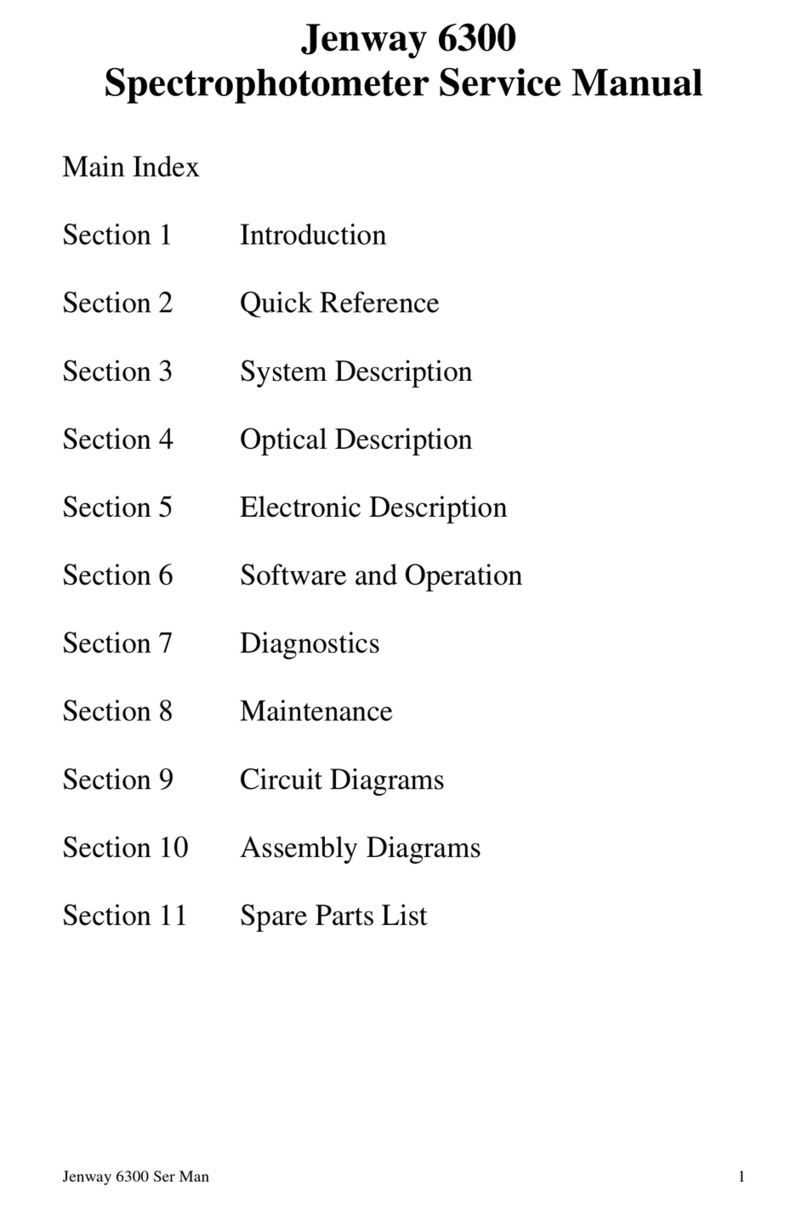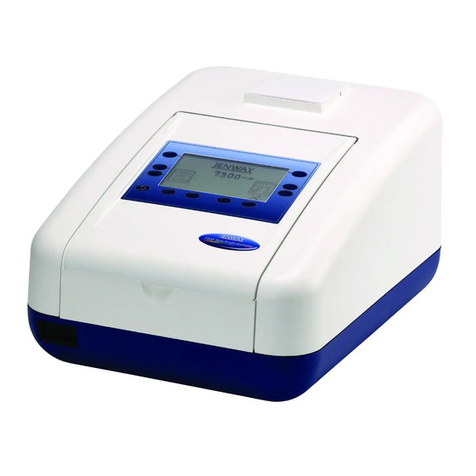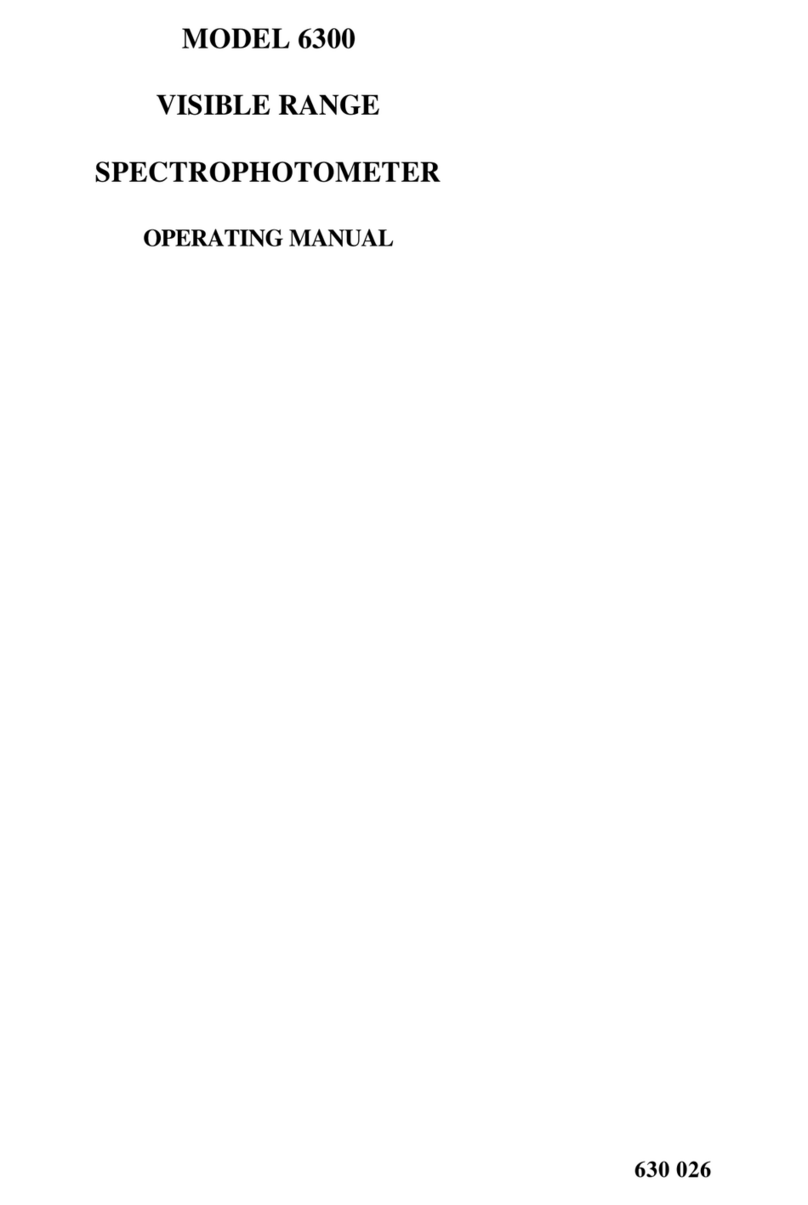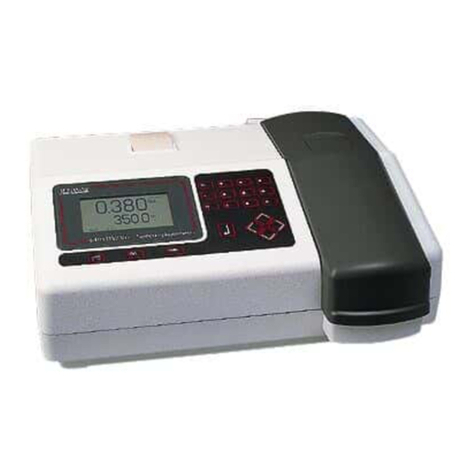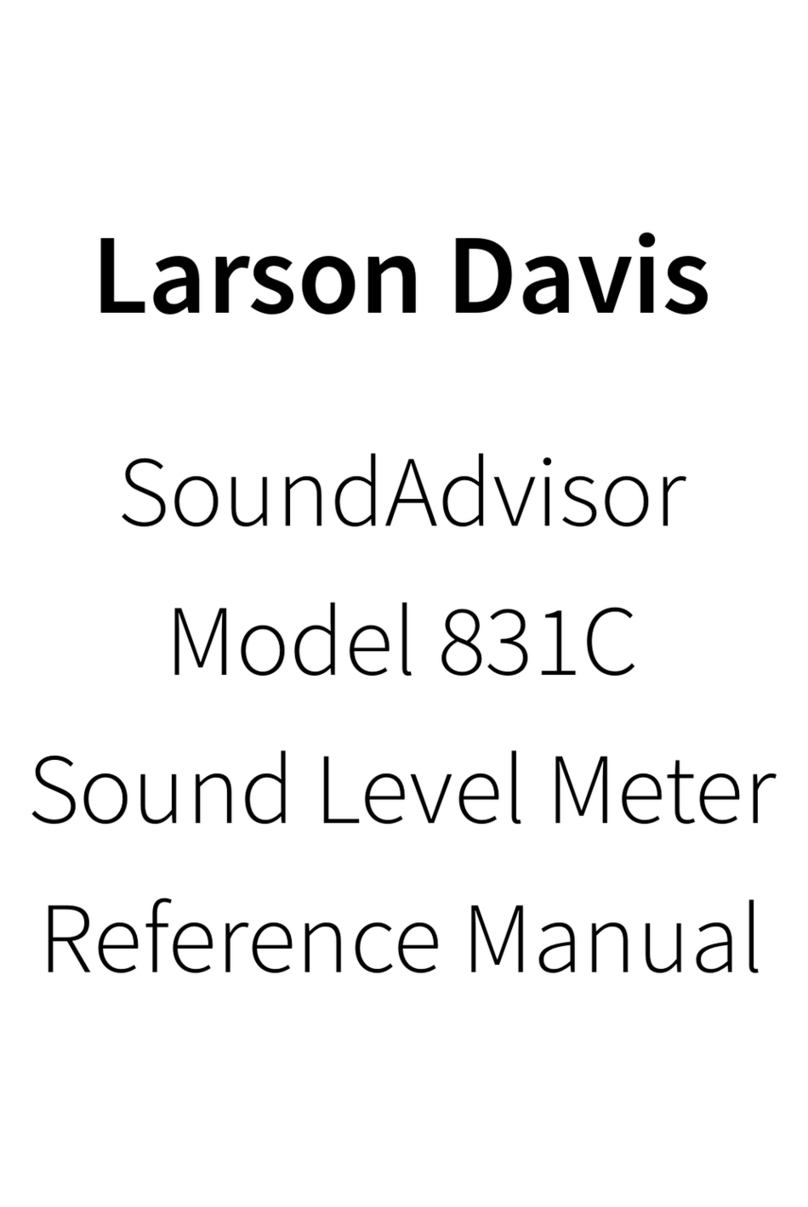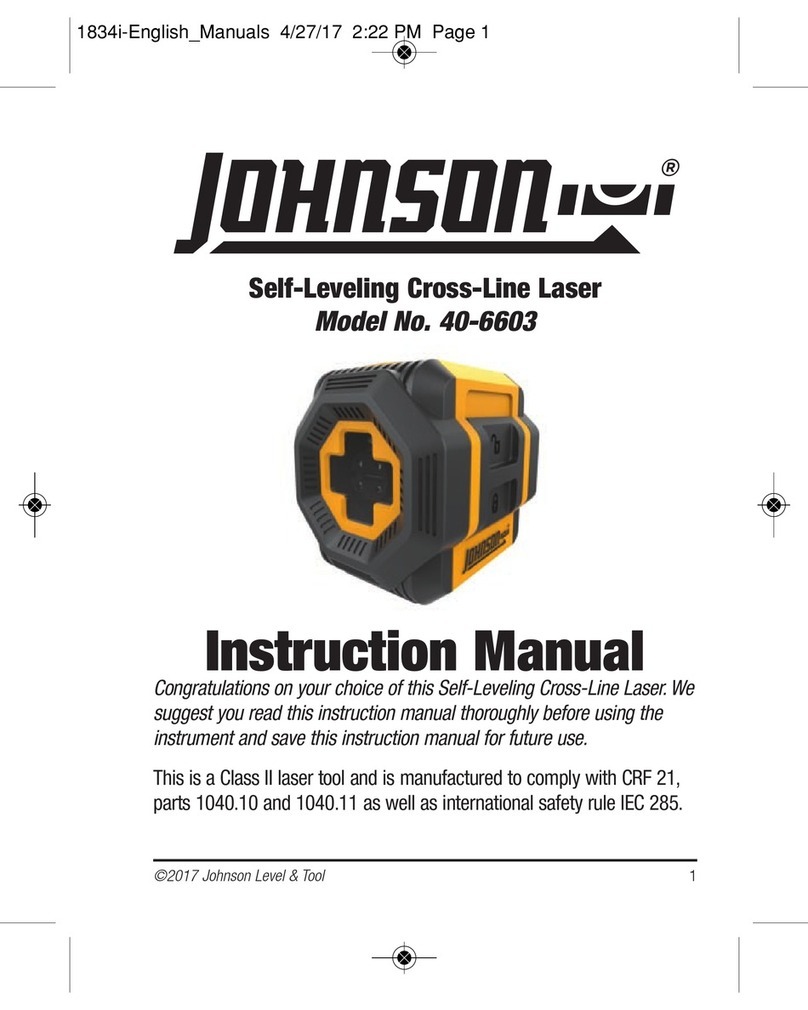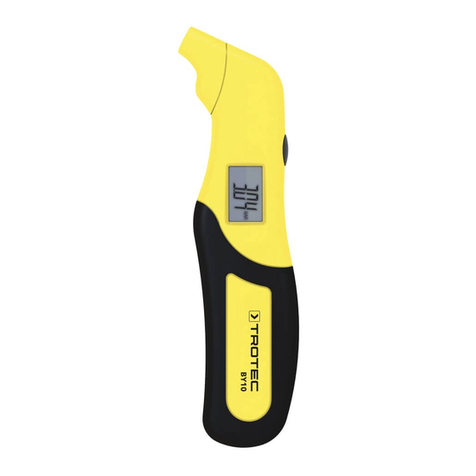jenway 6500 User manual

Jenway6500-05 Ser Man Page 1 of 105
Jenway 6500/05
Spectrophotometer Service Manual
Section 1 Introduction
Section 2 Quick Reference
Section 3 System Description
Section 4 Optical Description
Section 5 Electronic Description
Section 6 Software Description
Section 7 Diagnostics
Section 8 Maintenance
Section 9 Circuit Diagrams
Section 10 Assembly Diagrams
Section 11 Spare Parts List

Jenway6500-05 Ser Man Page 2 of 105
Section 1
Introduction
1.0 Index to Sections
1.1 About This Manual
1.2 Using This Manual
1.3 Warnings & Safe Practice
1.4 Standards & Certification
1.5 Ordering Spares
1.6 Returning Items
1.7 Contacting Jenway Limited

Jenway6500-05 Ser Man Page 3 of 105
Introduction.
1.0 Index to Sections
Section 1 – Introduction
1.0 Index to Sections
1.1 About This Manual
1.2 Using This Manual
1.3 Warnings & Safe Practice
1.4 Standards & Certification
1.5 Ordering Spares
1.6 Returning Items
1.7 Contacting Jenway Limited
Section 2 - Quick Reference
2.0 About ‘Quick Reference’
2.1 Specification
2.2 Main Sub-Assemblies
2.3 Power Supply Voltages
2.4 Signal Levels
2.5 Error Codes
2.6 Special Key Functions
2.7 Test Solutions
Section 3 - System Description
3.1 6500 & 6505 Comparison
3.2 Executable Programmes
3.3 Sub-Assemblies
3.4 Accessories
3.5 Outputs
Section 4 - Optical Description
4.1 Light sources
4.2 Stray Light Filters
4.3 Grating
4.4 Beam Splitter
4.5 Signal Detector

Jenway6500-05 Ser Man Page 4 of 105
Section 5 - Electronic Description
5.1 Power Supplies
5.2 Deuterium Lamp Supplies
5.3 Detector Circuits
5.4 Microprocessor and Memory Functions
5.5 Mouse driver & Parallel Port
5.6 Accessory driver PCB
Section 6 - Software Description
6.0 Warning
6.1 Start Up Routine
6.2 Main menu
6.3 Set Up Menus
6.4 Filing System
Section 7 – Diagnostics
7.1 The Diagnostics Menu
7.2 Linearised Voltage
7.3 Channel Outputs
7.4 Shutter and Filters
7.5 Lamp control
7.6 Motor Position Sensor
7.7 Wavelength Functions
7.8 Beam Splitter Functions
7.9 Zero Order Cal.
7.10 Calibrate Functions
Section 8 – Maintenance
8.1 Routine Maintenance
8.2 Dismantling
8.3 Energy Levels
8.4 Wavelength Calibration
8.5 Beam Splitter Calibration
8.6 A to D Calibration
8.7 D to A Calibration
8.8 Performance Verification

Jenway6500-05 Ser Man Page 5 of 105
Section 9 - Circuit Diagrams
9.10 Power Supply Schematic 640 008
9.11 Power Supply Layout 640 008
9.20 Deuterium Lamp Supply Schematic 640 506
9.21 Deuterium Lamp Supply Layout 640 506
9.30 Detector PCB Schematic 650 505
9.31 Detector PCB Layout 650 505
9.32 Beam Splitter PCB Schematic 650 010
9.33 Beam Splitter PCB Layout 650 010
9.40 Microprocessor PCB Schematic 650 006
9.41 Microprocessor PCB Layout 650 006
9.50 Mouse & Parallel Port PCB Schematic 650 012
9.51 Mouse & Parallel Port PCB Layout 650 012
9.60 Accessory Driver PCB Schematic 642 003
9.61 Accessory Driver PCB Layout 642 003
Section 10 - Assembly Diagrams
10.1 6500 Final Assembly 650 003
10.2 6505 Final Assembly 650 503
10.3 6500 Lower Case Assembly 650 005
10.4 6505 Lower Case Assembly 650 504
10.5 6500/05 Top Case Assembly 650 004
10.6 6500 Optics Assembly 650 016
10.7 6505 Optics Assembly 650 507
10.8 6500/05 Rear Panel Assembly 650 018
10.9 6500/05 Multi-cell Chamger Assembly 644 002
Section 11 – Spare Parts List
11.01 Packed Instrument
11.02 Top Case Assembly
11.03 Microprocessor PCB
11.04 Lower Case Assembly
11.05 Lamp Housing Assembly
11.06 Monochromator Assembly
11.07 Detector PCB
11.08 Power Supply PCB
11.09 Deuterium Lamp Supply PCB
11.10 Rear Panel Assembly
11.11 Mouse/Parallel Port PCB
11.12 Multi-Cell Changer PCB
11.13 Built-In Printer Option

Jenway6500-05 Ser Man Page 6 of 105
1.1 About This Manual
This manual covers the service, maintenance, calibration and repair
of the Jenway Ltd models 6500 and 6505 Spectrophotometers.
Throughout this manual all general statements and procedures
should be considered to be relevant for both models. Where a
statement or procedure is relevant to only one of the two models it
will be clearly stated in underlined italics, to which model it
relates, at the beginning of the relevant paragraph or section.
This manual must be used in conjunction with the Instruction
Manual for these models, as many of the routine maintenance
procedures detailed in the Instruction Manual are not repeated in
this Service Manual.
1.2 Using This Manual
This manual is only for the use of Engineers and Technicians who
have successfully completed a Jenway Ltd approved Service
Training course on the 6500 and 6505 Spectrophotometers.
Updates to this manual will be circulated through the Jenway Ltd
TSI (Technical Service Information) systems and to other
registered users of this manual. Please complete the form at the rear
of this manual to register your copy for future updates.
In practice Section 2 - Quick Reference and Section 8 –
Maintenance, with the Diagrams in Section 9, will be most
frequently used, however it is good practice to read the complete
manual initially and review it again periodically.
To find the information required refer to the Main Index or Index
to Sections to identify the relevant Section/page number required.

Jenway6500-05 Ser Man Page 7 of 105
1.3 Warnings & Safe Practice
Disconnect the mains supply when any covers are removed as there
are mains and high voltages present inside the unit that pose the
risk of electric shock at levels that are hazardous to life!
Do not look directly at the light sources or allow the light beam to
fall directly on the eyes, switch off or dim the lamps (as described
in the procedures) whenever possible and wear UV eye protection
at ALL times.
Both the UV and visible lamps get very hot when in use, always
allow time for them to cool down before removing them. Always
wear cotton gloves when removing faulty lamps and replacing
them with new ones.
Finger marks, dust and condensation can quickly destroy sensitive
and expensive optical components, always wear cotton gloves
when the optical bench is uncovered and handle any components
by their edges only. Never touch optical surfaces. Do not remove
optical covers unless the unit is in a clean, dust and condensation
free environment.
Many of the reagents, solutions and standards used for maintenance
and calibration are corrosive or hazardous, ensure all precautions
supplied with them are followed, where there is any doubt request a
MSDS (Material Safety Data Sheet) from the supplier.
These instruments can be used for analysing a broad range of
samples, do not handle them unless you are qualified to do so.
Ensure that the instrument has been correctly decontaminated
before working on it, specifically in areas where the instrument
may have been used for clinical, biological, corrosive or
radioactive samples.
1.4 Standards & Certification
No adjustments should be made to these instruments unless the test
and measurement equipment, signal source or filters to be used
have a current calibration certificate that is traceable to national or
international standards and that it is known that this test equipment

Jenway6500-05 Ser Man Page 8 of 105
is currently performing to the certified standards. All solutions and
reagents should be fresh and within any stated shelf life with a
certificate of analysis.
1.5 Ordering Spares
When ordering spare parts as detailed in this manual please quote
the Part Number and Description. These items should be ordered
from the original supplier of the equipment or your local Jenway
Limited Distributor.
1.6 Returning Items
Should it be necessary to return any item for any reason then this
should be done through the original supplier of the equipment or
your local Jenway Limited Distributor.
1.7 Contacting Jenway Limited
Before contacting Jenway Limited please check our web pages for
any information or updates that may be helpful to you.
www.jenway.com
Emails should be sent to sales@jenway.com
Fax: +44 1371 821083
Phone: +44 1371 820122
Please note no items can be returned (or will be accepted by)
Jenway Limited without a Returns Authorisation number (RA
number) and a completed Safety Clearance and Decontamination
certificate.

Jenway6500-05 Ser Man Page 9 of 105
Section 2
Quick Reference
2.0 About ‘Quick Reference’
2.1 Specification
2.2 Main Sub-Assemblies
2.3 Power Supply Voltages
2.4 Signal Levels
2.5 Error Codes
2.6 Special Key Functions
2.7 Test Solutions

Jenway6500-05 Ser Man Page 10 of 105
2.0 About ‘Quick Reference’
This section contains a selection of the key information that is
often forgotten or difficult to find when required. Use Quick
Reference as a memory jogger, but for more information check out
the references to the main sections on each point.
2.1 Specification
Wavelength Range 6500 320nm to 1100nm
6505 190nm to 1100nm
Wavelength Resolution 0.1nm
Wavelength Accuracy 1nm
Spectral Bandwidth 1.8nm
Light Source Visible; Tungsten Halogen
Ultra Violet; Deuterium
UV Lamp Auto Off Selectable 320nm to 390nm
Optics Split Beam
Transmittance Range; 0 to 199.9%
Resolution; 0.1%
Absorbance Range; -0.300A to 3.000A
Resolution; 0.001A
Concentration Range; -300 to 9999
Resolution; 0.001, 0.01, 0.1, 1
Units;ppb, ppm, µgl-1, mgl-1, gl-1, M, %, blank.
Spectrum Abs. %T or Conc. Against wavelength
Scan Interval Scan Speed
5nm 1200nm/min
1nm 400nm/min
0.2 166nm/min
Stray Light Less than 0.05% @340nm

Jenway6500-05 Ser Man Page 11 of 105
2.2 Main Sub-Assemblies
650 004 Top Case Assembly – includes the following…
640 058 Keypad
650 021 Operating System on PCMCIA Card
650 006 Microprocessor PCB
012 092 LCD Module
650 504 Lower case Assembly – includes the following…
640 025 Power Supply PCB
640 516 Deuterium Power supply PCB
650 505 Detector PCB
650 012 Mouse Interface PCB
644 001 Multi-cell Changer with PCB
060 342 Cooling Fan
010 039 Torroidal Transformer
Optics Assembly – includes the following…
012 075 Tungsten Halogen lamp
640 508 Deuterium Lamp
650 507 Monochromator assembly
650 010 Beam Splitter PCB
032 005 12V Solenoid
Other Items – including…
060 358 Mouse
016 058 1.6A Fuse for 220V supply
3.15A Fuse for 110V supply

Jenway6500-05 Ser Man Page 12 of 105
2.3 Power Supply Voltages
Before commencing more complex fault finding it is important to
check all the internally generated supply voltages are correct. The
following list is a useful guide to help quickly check these are
functioning correctly. Not all the points where these voltages can
be measured are given and where the voltage is stated as
unregulated variations may occur. In general regulated supplies
should vary by no more than +/-5% from their nominal value.
Tungsten Lamp Supply, 12V dc regulated and set by VR1,
measure at PL5 pin 3 with respect to PL5 pin 4 on the power
supply PCB and at the terminals on the lamp base with the lamp
fitted.
Solenoid, Relay and Fan Supplies, 12V dc regulated and pre-set,
measure at PL5 pin 1 with respect to PL5 pin 2 on the power
supply PCB and on the solenoid and fan terminals and at the
cathode of D3 on the Deuterium Power supply PCB with respect to
0V.
Digital Supply, 5V dc regulated and pre-set, measure across C17
on the power supply PCB and across C62 on the microprocessor
PCB.
Stepper Motor Drive, 30V dc unregulated, also acts as
unregulated supply for all above, measure between Star3 and Star 2
on power supply PCB.
LCD Supply, -18V dc regulated and pre-set, measure across the
outside pins of REG. 5 (7918) on the power supply PCB.
DAC Supply, 12V dc regulated and pre-set, measure across the top
two pins of REG. 4 (7812) on the power supply PCB.
Deuterium PCB Supplies, 24V dc unregulated, measure across
the top two pins of REG1 (7812) on the Deuterium Lamp Supply
PCB. 12V dc regulated and pre-set, measure across the bottom two
pins of REG. 1 (7812) on the Deuterium Lamp Supply PCB. 5V dc
regulated and pre-set, measure across pins 4 and 8 of IC1 (LM311)
on the Deuterium Lamp Supply PCB. 30V dc unregulated, measure
from the top of R120 (junction with R100) with respect to the top
of R102 in the centre of the Deuterium Lamp Supply PCB. 14V dc

Jenway6500-05 Ser Man Page 13 of 105
regulated and pre-set, measure from the top of R101 with respect to
the top of R102 on the Deuterium Lamp Supply PCB.
Deuterium Lamp Heater, 2.5V dc (1.0V when arc has struck)
regulated and pre-set, measure across R9 on the Deuterium Lamp
Supply PCB or between the two blue wires on pins 2 and 3 of the
Deuterium Lamp Socket (SK1).
Deuterium Lamp Arc, 170V dc pulsed to strike, 300mA at 70V
(Temperature Compensated) when arc has struck. Measure across
R119 on the Deuterium Lamp Supply PCB and between pins 1 and
3 on the Deuterium Lamp Socket (SK1).
Detector PCB Supplies, 5Vdc regulated and pre-set, measure
across D2 on the Detector PCB. –5V dc regulated and pre-set,
measure across D3 on the Detector PCB.
Sampling Accessory PCB, 5Vdc regulated and pre-set, measure
across C15. 15V dc regulated and pre-set, measure between R18 at
junction with REG 2 and junction of D1 and C22.
2.4 Signal Levels
All analogue signal processing is dealt with on the Detector PCB
and the Beam Splitter PCB. Relevant signals from these PCBs are
shown in the Diagnostics Screen as Linearised Voltage, in mV, and
CH0, CH1, CH2 and CH3 or CH4 in ‘counts’ directly from the A
to D converter. For more detailed definitions of these terms see
Section 5.3 - Detector Circuits and Section 7.01 – The Diagnostics
Menu, 7.02 – Linearised Voltage and 7.03 Channel Outputs.
The Linearised Voltage can be used to check lamp energy (ageing),
the correct functioning of the IR Stray Light filter and the UV Stray
Light Filter as well as the Dark Shutter.
U V Energy, Set wavelength to 190nm, Dark Shutter open, IR
stray light filter closed, UV stray light filter open; Linearised
voltage must be greater than 20mV.
Visible Energy, Set wavelength to 700nm, Dark Shutter open, IR
stray light filter open, UV second order stray light filter closed;

Jenway6500-05 Ser Man Page 14 of 105
Linearised Voltage must be greater than 1000mV and less than
3400mV.
Dark Current, Set wavelength to 320nm, Dark Shutter closed, IR
stray light filter closed, UV second order stray light filter open;
Linearised Voltage should be zero +/- 6mV.
320nm Output, Set wavelength to 320nm, UV lamp off, Dark
Shutter open, IR stray light filter closed, UV second order stray
light filter open; Linearised voltage must be greater than 17mV.
Typical values for units fitted with the Richardson grating (Serial
Numbers greater than 2000) are 40mV, for those fitted with the
American Holographics grating (Serial Numbers less than 2000)
typical values will be 17 to 20mV.
Beam Splitter Dark Current, Set wavelength to 320nm, UV lamp
off, Dark Shutter closed, IR stray light filter closed, UV second
order stray light filter open; CH4 should be zero +/- 100 counts.
Beam Splitter Output, Set wavelength to 320nm, UV lamp off,
Dark Shutter open, IR stray light filter closed, UV second order
stray light filter open; CH4 should be greater than 250 counts but
less than1000.
2.5 Error Codes
A number of dialogue boxes are generated with messages relating
to fault conditions, these are detailed below with a brief description
of some of the most common causes for these errors.
Dark Level Too High, Sample chamber cover left open during
start up tests or a calibration, dark shutter stuck open, solenoid or
solenoid drive/connections faulty, Detector PCB failure.
Light Level Too Low, Blank too optically dense, plastic or glass
cuvettes used in the UV range, miss-alignment of cell carriage,
wrong lamps fitted, lamps miss-aligned, dark shutter stuck closed.
This may also be due to the contamination of optical surfaces.
Unable To Detect Peak Light Level, Cuvette left in sample
chamber during start up tests, miss-aligned cell carriage, wrong

Jenway6500-05 Ser Man Page 15 of 105
lamps fitted, miss-aligned lamps or lamp carriage, contaminated
optical component.
Unable To Detect Sensor Vane, Grating position opto-coupler
faulty or connections broken/intermittent, incorrect wavelength
calibration carried out, check connections to stepper motor and
check PL3 connections on Power Supply PCB.
Calculated Factor Outside Limits, The standard used to calibrate
a concentration measurement cannot give the standard value
entered, this can be because the standard is too optically dense or
too similar to the blank. Alternatively the incorrect standard value
may have been entered.
Warning Tungsten Lamp Failure, Tungsten lamp filament
broken, wrong type of tungsten lamp fitted, no tungsten lamp
fitted, cables to lamp base broken/damaged, check SK4 on power
supply PCB.
Warning Deuterium Lamp Failure, Deuterium lamp faulty, cable
disconnected, 6500 set up as 6505.
Critical Error Calibration Data Failure, During the start up test
sequence the microprocessor has been unable to detect the
calibration data stored in the E2PROM on the Detector PCB. This
may indicate a faulty Detector PCB or that the connections to the
Detector PCB are not made or are intermittent.
Critical Error Wavelength Failure, Monochromator has received
a command to drive the grating to a wavelength outside the range
of -200 to 1200nm, problem can only be produced by incorrect use
of functions in the Diagnostics Mode. It may also happen through
software corruption, recover by deleting all files and re-loading the
executable programme from the application card supplied.
2.6 Special Key Functions
There are a number of special key functions for use by trained
engineers, do not use them unless you are fully conversant with all
the procedures these invoke.

Jenway6500-05 Ser Man Page 16 of 104
Power On Reset, Hold the <Enter> key depressed while turning
on the power. This resets the default operating parameters, it does
not clear all the memory but is useful in correcting many software
conflicts.
Software Version, The version of software loaded (i.e. Version 1.4
etc) can be displayed by pressing the <+/-> key when the main
menu screen is active.
Skip Power On Tests, Hold the decimal point <.> key depressed
while turning the power on, this function must only be used for
fault finding procedures, taking readings on an instrument started
in this way will produce unpredictable errors.
Diagnostics Mode, Hold the right arrow <>> key depressed while
turning the power on, do not enter this mode unless you have the
correct training and equipment, making adjustments here can
permanently damage the instrument.
6500/6505 Select, Pressing the right arrow <>> key in the
diagnostics mode will invoke the 6505 software modules, pressing
the left arrow key <<> will invoke the 6500 software modules. Of
course a 6505 can be run as a 6500, but errors will occur in the
opposite situation, ensure the correct option is selected before
leaving the Diagnostics Menu.
Load New Application, Hold down the zero <0> key while
turning the power on, do not do this unless you have an up to date
application card to re-load, invoking this function is irreversible, if
in doubt use the Load New Application function in the Instrument
set Up Menu. Using these short cut keys for loading a new
application does not reset the user variables stored in battery
backed RAM. If the new application is significantly different from
the previous one, then these user variables may be misinterpreted.
It is good practice to always follow this action with a power on
reset that will set the user variables to their default values.

Jenway6500-05 Ser Man Page 17 of 105
2.7 Test Solutions
1. Wavelength Standard
Holmium Perchlorate – 5% w/v solution of Holmium Oxide in
1.4N Perchloric acid, this will give absorbance maxima at
241.0, 278.1, 287.0, 361.4, 416.1, 451.1, 485.3, 536.5 and
640.5nm.
2. Absorbance Standard
Potassium Dichromate – 100.0mg/l in 0.005M Sulphuric Acid
(use the Sulphuric Acid as the blank). This will give
Absorbance values of 1.071 at 350nm, 0.484 at 313nm, 1.444 at
257nm, 1.242 at 235.
Potassium Dichromate – 50.0mg/l in 0.005M Sulphuric Acid
(use the Sulphuric Acid as the blank). This will give
Absorbance values of 0.536 at 350nm, 0.242 at 313nm, 0.722 at
257nm, 0.621 at 235.
3. Stray Light Standard
Sodium Nitrate – 50g/l in deionised water, should give less than
0.1% transmittance at 340nm.
Sodium Iodide – 10g/l in deionised water, should give less than
0.1% transmittance at 220nm.
WARNING
All these solutions are hazardous and the
manufacturer/suppliers safety precautions should be
carefully followed at all times in preparation, use and
storage.

Jenway6500-05 Ser Man Page 18 of 105
Section3
System Description
3.1 6500 & 6505 Comparison
3.2 Executable Programmes
3.3 Sub-Assemblies
3.4 Accessories
3.5 Outputs

Jenway6500-05 Ser Man Page 19 of 105
3.1 6500 & 6505 Comparison
The models 6500 and 6505 share the majority of common sub-
assemblies. However the 6500 is not fitted with the Deuterium
Lamp power Supply PCB and of course the Deuterium Lamp itself.
Because of this the optics and monochromator are slightly
different, but in arrangement only.
The Detector and Detector PCBs are specific to each model,
650 008 for the 6500 and 650 505 for the 6505.
3.2 Executable Programmes
Both models use the same executable programme, which can be
updated by re-loading new versions from a Flash memory card
inserted in the PCMCIA card slot. A back-up copy of this
executable programme, on an application card, is included when
the units are supplied.
The mouse driven system makes both of these models very user
friendly, but operation is still possible using the navigation keys on
the keypad and the short cut icons on the display.
The PCMCIA card slot may also be used for storing results and
methods on an SRAM card and when stored as ASCII files these
can be transferred to a PC for further manipulation or storage.
3.3 Sub-Assemblies
The 6500 and 6505 can easily be broken down into sub-assemblies
for the purposes of repair or replacement. All the PCBs are easily
removed, see Section 8.2 – Dismantling. The monochromator and
lamp carriage, which together contain most of the optical
components are both replaceable sub-assemblies. There are a
number of sampling accessories that can be fitted into the sample
compartment and removed with very little dismantling.
See Section 2.2 for details of the main sub-assemblies and Section
11 for details of other spare parts. The following paragraph lists the
sampling accessories available.

Jenway6500-05 Ser Man Page 20 of 105
3.4 Accessories
The following sampling and temperature control accessories are
available, where necessary additional service information for these
accessories is available on request. The development of other
sampling accessories is continuous, please check current brochures
or www.jenway.com for up-to-date information.
644 001 Motorised Eight Position Cell Holder
644 003 Rack to Hold 10mm Cells for Above
649 001 Water Jacketed Cell Holder as Above
648 001 Water Jacketed Single Cell Holder
642 001 Sipper Pump
647 001 Temperature Controlled Sipper Pump
645 001 Vacuum Pump
643 001 Peltier Temperature Control System
646 002 Universal Test Tube Holder
630 003 20 to100mm Single Cell Holder
Other accessories include:
641 001 Internal 40 Column Printer
542 009 Interface Cable Kit
640 133 Dust Cover
3.5 Outputs
The 6500 and 6505 have analogue, RS232 and parallel centronics
outputs.
Details of the level of the analogue output for the different ranges
that may be selected on the instruments is given in Section 6.3 of
the Instruction Manual.
Pin configuration for the RS232 socket is given in Section 6.2 of
the Instruction Manual. Section 6.1 of the Instruction Manual gives
details of the various ASCII codes that may be transmitted to the
6500 or 6505 to remotely control them.
This manual suits for next models
1
Table of contents
Other jenway Measuring Instrument manuals
Popular Measuring Instrument manuals by other brands
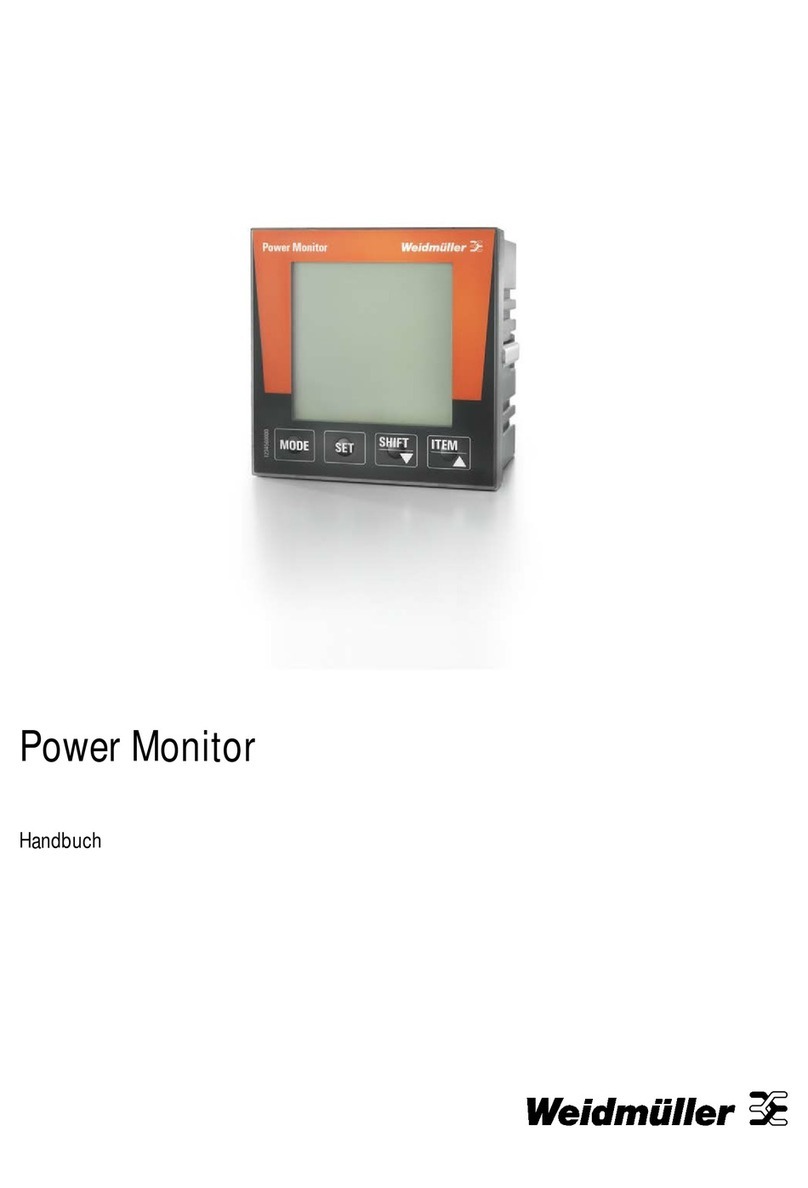
Weidmüller
Weidmüller Power Monitor manual
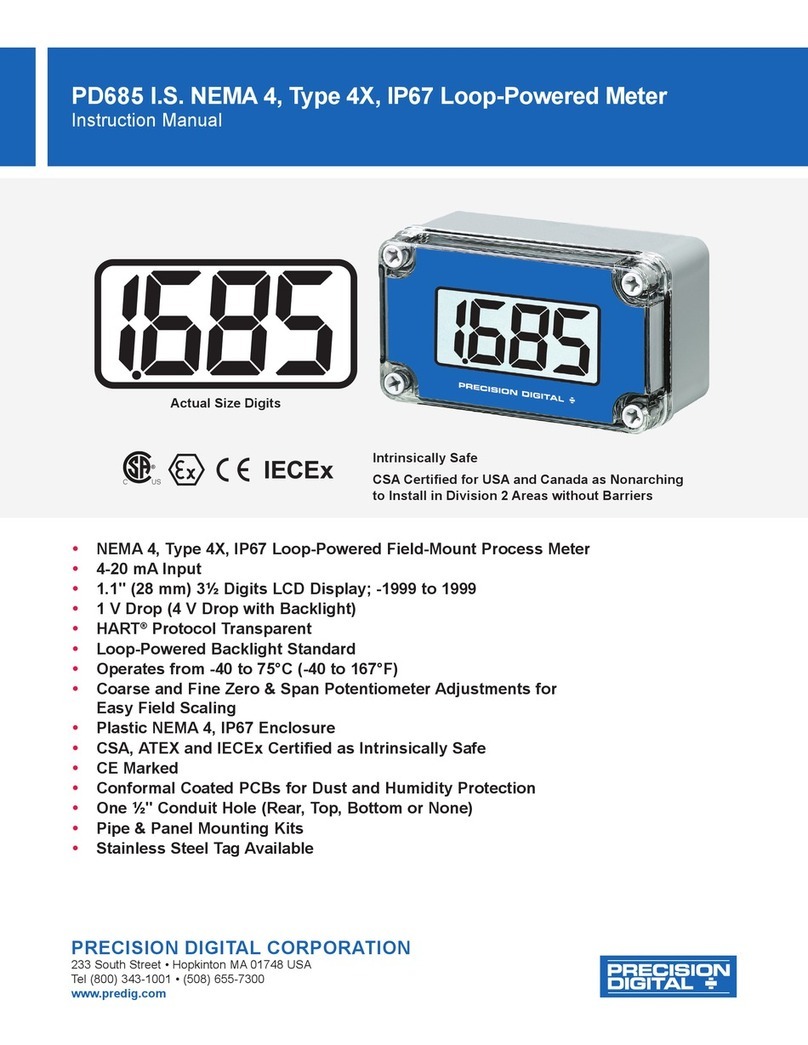
Precision Digital Corporation
Precision Digital Corporation PD685 instruction manual
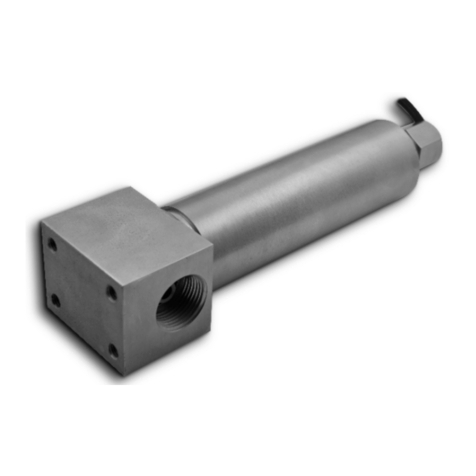
Pyxis
Pyxis ST-525SS user manual
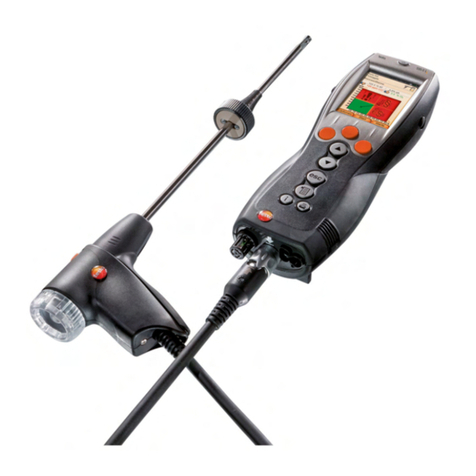
TESTO
TESTO 330 instruction manual

NorthStar
NorthStar NP2 Installation and operation manual
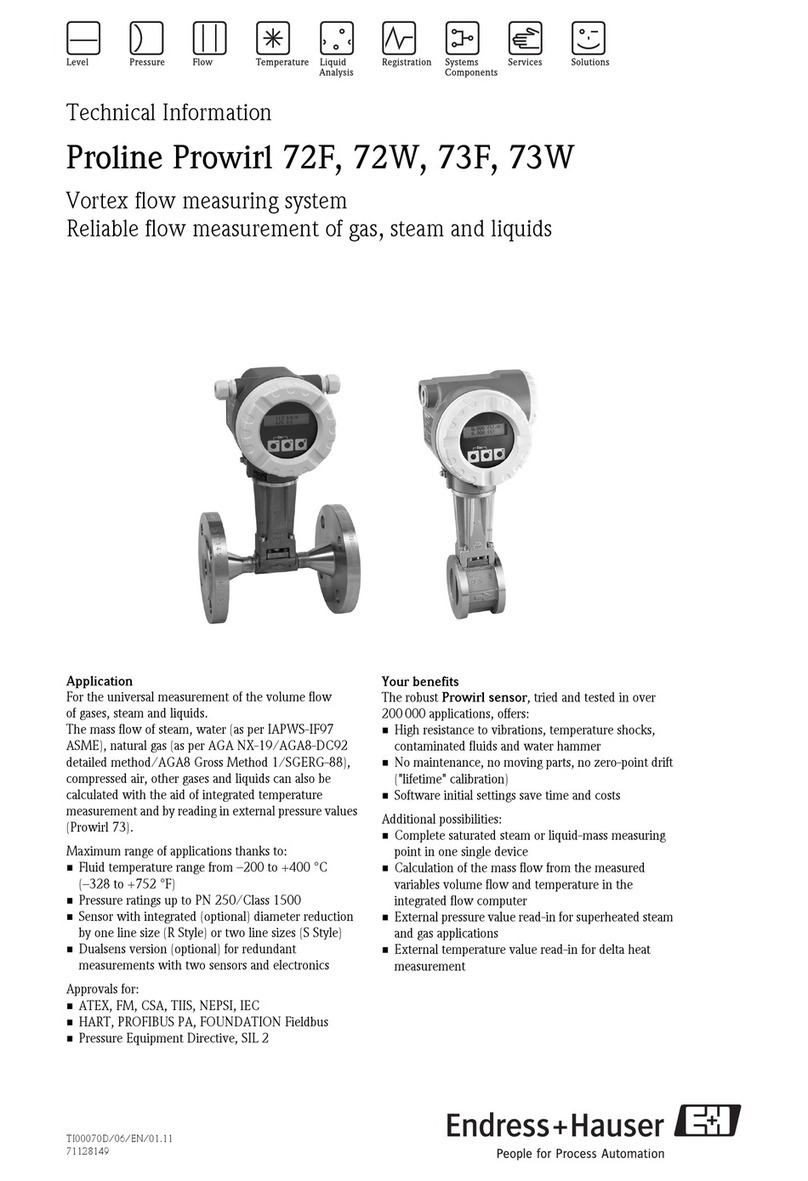
Endress+Hauser
Endress+Hauser Proline Prowirl 72W technical information
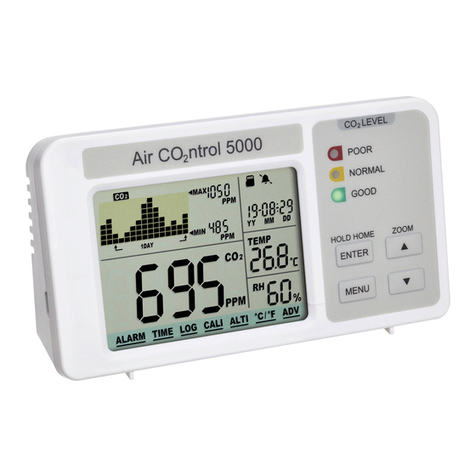
Dostmann Electronic
Dostmann Electronic 31.5008.02 Operating instruction

VWR
VWR 665-0309 operating manual
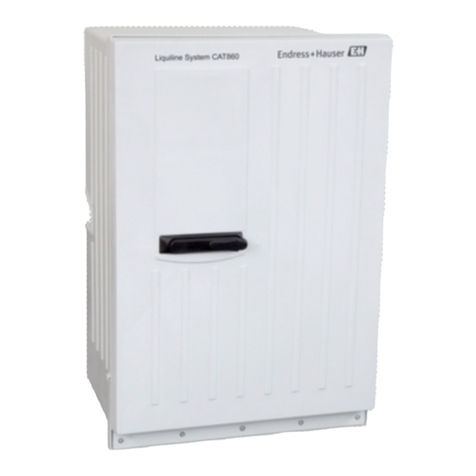
Endress+Hauser
Endress+Hauser Liquiline System CAT860 operating instructions
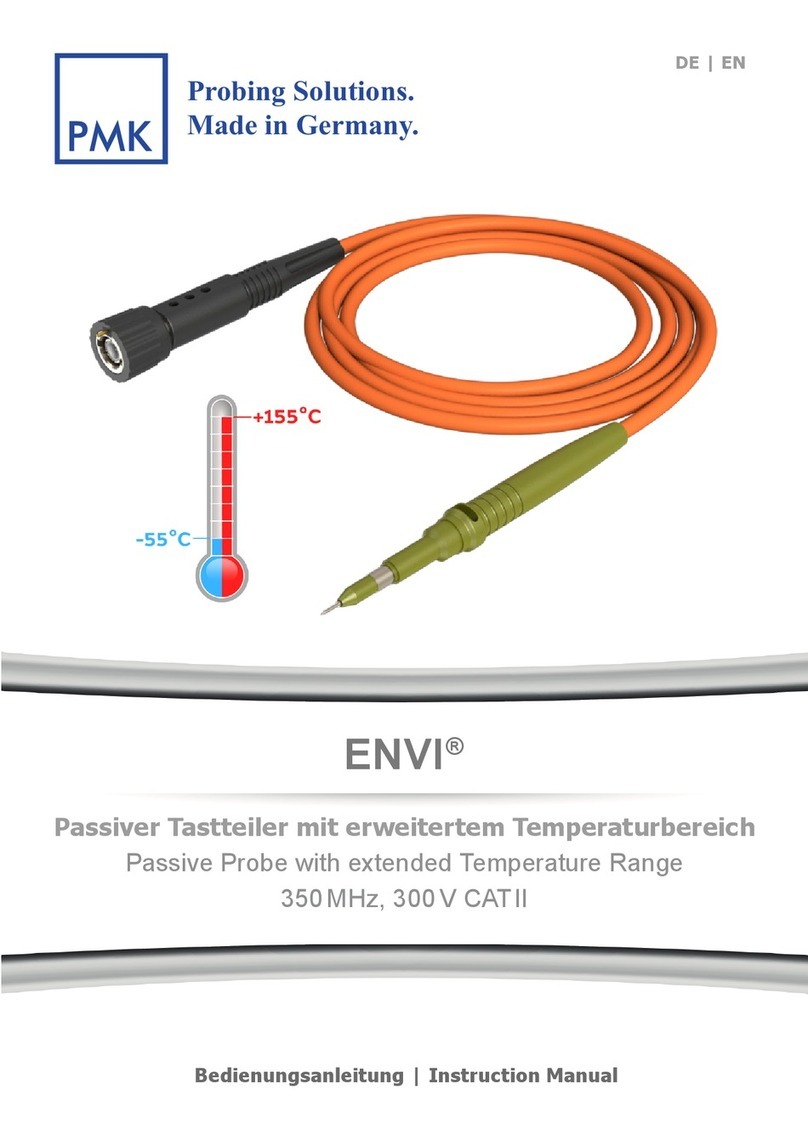
PMK
PMK ENVI PHT 312-RO instruction manual
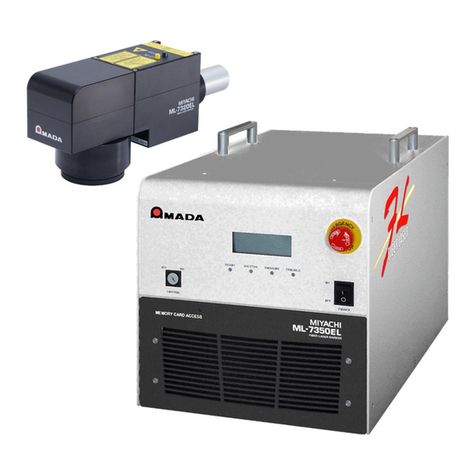
Amada
Amada ML-73 EL Series Operation manual

IFM Electronic
IFM Electronic OW installation instructions
